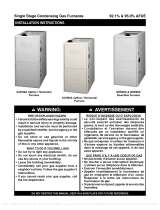
6
2. A carbon monoxide detector shall be
located in the room that houses the
appliance or equipment and shall:
a. Be powered by the same electrical
circuit as the appliance or equipment
such that only one service switch
services both the appliance and the
carbon monoxide detector;
b. Have battery back-up power;
c. Meet ANSI/UL 2034 Standards and
comply with NFPA 720 (2005 Edi-
tion); and
d. Have been approved and listed by a
Nationally Recognized Testing Labo-
ratory as recognized under 527
CMR.
3. A Product-approved vent terminal must
be used, and if applicable, a Product-
approved air intake must be used. In-
stallation shall be in strict compliance
with the manufacturer’s instructions. A
copy of the installation instructions shall
remain with the appliance or equipment
at the completion of the installation.
4. A metal or plastic identification plate
shall be mounted at the exterior of the
building, four feet directly above the
location of vent terminal. The plate shall
be of sufficient size to be easily read
from a distance of eight feet away, and
read “Gas Vent Directly Below”.
(b) For direct-vent appliances, mechanical-
vent heating appliances or domestic hot
water equipment where the bottom of the
vent terminal and the air intake is installed
above four feet above grade the following
requirements must be satisfied:
1. If there is not one already present, on
each floor level where there are
bedroom(s), a carbon monoxide de-
tector and alarm shall be placed in the
living area outside the bedroom(s). The
carbon monoxide detector shall com-
ply with NFPA 720 (2005 Edition).
2. A carbon monoxide detector shall:
a. Be located in the room that houses
the appliance or equipment;
b. Be either hard-wired or battery pow-
ered or both; and
c. Shall comply with NFPA 720 (2005
Edition).
3. A Product-approved vent terminal must
be used, and if applicable, a Product-
approved air intake must be used. In-
stallation shall be in strict compliance
with the manufacturer’s instructions. A
copy of the installation instructions shall
remain with the appliance or equipment
at the completion of the installation.
Location
The furnace must be installed on a level surface,
and as close to the center of the air distribution
system as possible. See Table 1 for overall
dimensions to determine the required clear-
ances in hallways, doorways, stairs, etc. to
allow the furnace to be moved to the installation
point. The furnace must be installed so that all
electrical components are protected from wa-
ter.
Minimum clearances to combustible materials
are listed in Table 3. Access for positioning and
servicing must be considered when locating the
unit. Twenty four inches is the minimum required
clearance for servicing the unit. Thirty inches is
the minimum required clearance for positioning
the unit. Thirty six inches is the recommended
clearance from the front of the unit. Please note
that a panel or door can be located such that the
minimum clearance on the rating plate is satis-
fied, but that panel or door must be removable
and allow the appropriate clearance for your
installation.
This furnace is certified for use on wood flooring.
The furnace must be installed on a solid surface
and must be level front to back and side to side.
This furnace must not be installed directly on
carpeting, tile, or any combustible material other
than wood flooring.
A gas-fired furnace installed in a residential
garage must be installed so that the bottom of the
burners and igniter are located a minimum of 18”
from the floor. The furnace must be located or
protected to avoid physical damage by vehicles.




















